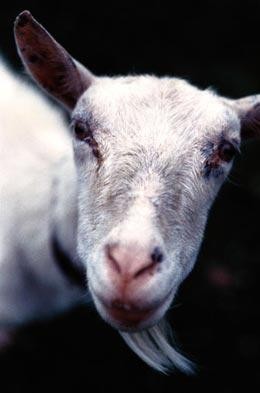How Does The Fda Regulate Engineered Animals Like These?
Drug bureau opens door to market blessing for transgenic animals.

A transgenic goat, soon to be acquiescent to regulation Credit: Punchstock
After ten years of anticipation and dorsum-room wrangling, on eighteen September the U.s.a. Food and Drug Administration (FDA) published a document outlining how it proposes to regulate genetically engineered animals. The proposed regulations effectively care for such animals as drugs in society to provide grounds for FDA regulation.
In a 25-folio draft "guidance" (pdf) the agency responsible for the condom of US food and medicines effectively opened its regulatory doors to genetically engineered animals, exist they intended as pets, as livestock bound for the dining table or every bit living drug factories. Although the proposed regulations are non-binding, the manufacture is expected to follow them closely as a guide to gaining marketing approvals. The guidelines volition exist finalised later a 60-day annotate catamenia.
The FDA is trying to regulate this engineering science nether laws that were never intended to regulate genetically engineered animals Doug Gurian-Sherman , Union of Concerned Scientists
The guidance covers details of what the FDA will need to know about the identification, characterization, manufacturing processes and labelling of the animals in question, likewise equally the evidence it will crave of their safety and efficacy in the use envisaged. It suggests that the FDA will focus its regulatory attending on situations in which transgenic animals may have environmental impacts, pose risks to animal or human health, or seem to raise prophylactic questions the producers have non addressed.
The agency has premised the rules on an unusual reading of the federal Food, Drug and Cosmetic Act, saying that the inserted Deoxyribonucleic acid used to alter an fauna can be regulated equally a "new brute drug" under the 1938 police from which the agency draws much of its regulatory clout. Under this estimation, the aforementioned gene inserted into two different animals of the same species on separate occasions creates two different entities to regulate, considering Dna integrates itself into the genome pretty much at random. Yet, the offspring of genetically modified animals will be, in regulatory terms, the same affair equally their parents.
Nosotros are non interested in having an application from every postdoc making a knockout mouse Larisa Rudenko , FDA
The guidance is being released now "because commercialization of these animals is no longer 'over the horizon'," Randall Lutter, the FDA's deputy commissioner for policy, told reporters on a briefing phone call on Thursday. "Genetic engineering of animals is here and has been for some time," added Larisa Rudenko, a senior adviser for biotechnology at the agency's Eye for Veterinary Medicine. "Every bit regulators, we intend to provide a rigorous, risk-based regulatory path," ensuring the wellness of both the animals and people.
Mystery meat
The new regulations are unlikely to have an impact on about bench scientists. The bureau says genetically engineered laboratory animals are a "master" instance where it would exercise its discretion not to regulate. "In general we are not interested in having an application from every postdoc and grad pupil making a knockout mouse for this that or the other thing," said Rudenko.
The guidance is going to ensure that we tin reach the very compelling benefits of genetic engineering of animals. Barbara Glenn , BIO
The bureau says it volition also accept what some would see every bit a lite bear upon in not requiring foods from genetically engineered animals to exist labelled as such unless the engineering science was specifically designed to modify their nutritional values, or if it did so by hazard. With respect to food safety, the proposed regulations are similar in substance to those agreed in July by a 176-nation job force that considered how best to assess the safety of foods from genetically engineered animals.1
The biotechnology industry, which has long urged the agency to issue such rules, praised the draft. Barbara Glenn, the managing managing director for creature biotechnology at the Biotechnology Industry Organisation in Washington DC, says that about a dozen of her group's 1,200 member companies are currently developing genetically engineered animals. "The guidance is going to ensure that we can reach the very compelling benefits of genetic engineering of animals," she says. "It simply allows industry to motion forward."
Behind closed doors
Consumer groups, by contrast, were highly critical. They said that the guidance was far too vague, leaving consumers to trust that FDA will conduct acceptable assessments of animals' environmental and safety impacts.
They besides noted that because the animals will be dealt with as new drugs, the cess of their safety will be conducted behind airtight doors at the agency — guarded by law as proprietary information, as is the example with conventional drug applications.
"The FDA is turning somersaults to try to adequately regulate this technology under laws that were never intended to regulate genetically engineered animals," says Doug Gurian-Sherman, a senior scientist at the Spousal relationship of Concerned Scientists in Washington DC. "It may be that a new constabulary and new regulations that are better adapted and more specifically designed to address the unique types of concerns that these animals raise would exist a better arroyo."

References
-
Codex Alimentarius Committee: Guideline for the Conduct of Food Safety Assessment of Foods Derived from Recombinant-DNA Animals; in ALINORM 08/31/34, Appendix Ii.
Related links
Rights and permissions
Nearly this article
Cite this article
Wadman, M. FDA to regulate genetically engineered animals. Nature (2008). https://doi.org/10.1038/news.2008.1120
-
Published:
-
DOI : https://doi.org/ten.1038/news.2008.1120
Source: https://www.nature.com/articles/news.2008.1120
Posted by: reyesaffir1968.blogspot.com




0 Response to "How Does The Fda Regulate Engineered Animals Like These?"
Post a Comment